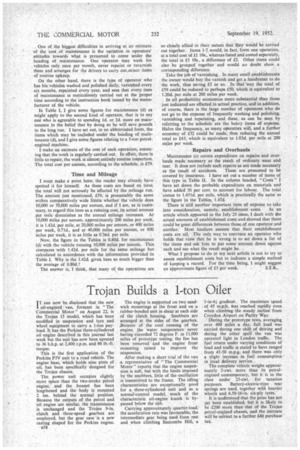Trojan Builds a 1-ton Oiler
Page 124

If you've noticed an error in this article please click here to report it so we can fix it.
IT can now be disclosed that the new
oil-engined van, forecast in "The Commercial Motor" on August 22, is the Trojan 15 model, which has been modified in suspension and tyre and wheel equipment to carry a 1-ton payload. It has the Perkins three-cylindered oil engine described in this journal last week but the unit has now been uprated to 36 b.h.p. at 2,400 r.p.m. and 90 lb.-ft. torque.
This is the first application of the Perkins P3V unit to a road vehicle. The engine base, which holds nine pints of oil, has been specifically designed for the Trojan chassis.
The power unit occupies slightly more space than the two-stroke petrol engine, and the bonnet has been lengthened and the body is mounted 2 ins, behind the normal position. Because the outputs of the petrol and oil engine are similar, the transmission is unchanged and the Trojan 9-in. clutch and three-speed gearbox are employed, but the gear case' is a new casting shaped for the Perkins engine.
a58 The engine is supported on two sandwich mountings at the front and on a rubber-bonded unit in shear at each side of the clutch housing. Snubbers are arranged at the sides of the gearbox. _Because of the cool running of the engine, the water temperature never having exceeded 72 degrees F. in 11,000 miles of prototype testing, the fan has been removed and the engine front mounting raised to improve the suspension.
After making a short trial of the van a representative of "The Commercial Motor" reports that the engine suspension is soft, but with the limits imposed by the snubbers, little of the oscillation is transmitted to the frame. The idling characteristics are exceptionally good for a three-cylindered unit and as a normal-control model, much of the characteristic oil-engine knock is bypassed below the cab.
Carrying approximately quarter-load, the acceleration rate was favourable, the intermediate gear being used from rest and when climbing Succombs Hill, a 1-in-41 gradient. The maximum speed of 45 m.p.h. Was reached rapidly even when climbing the steady incline from Croydon Airport on Purley Way.
During the prototype tests, averaging over 400 miles a day, full load was carried during one shift of driving and during the other spell the van was operated light in London traffic. The Nei return under varying conditions of load and traffic is stated to have ranged from 45-50 m.p.g. and there was only a slight increase in fuel consumption in local delivery service.
The complete vehicle weighs approximately 2-cwt. more than its petrolengined contemporary, but it is in the class under 25-cwt. for taxation purposes. Battery-electric-type rear springs are used, together with heavier wheels and 6.50-16-in, six-ply tyres.
It is understood that the price has not yet been established, but it is likely to be £200 more than that of the Trojan petrol-engined chassis, and the increase _ will be subject to a further £40 purchase tax.




































































































































































